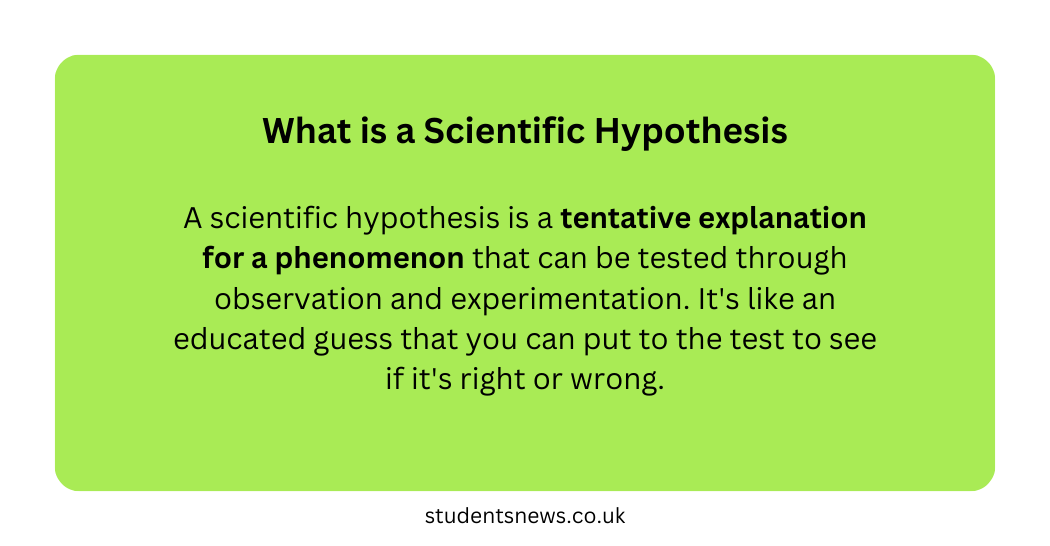What is scientific hypothesis
A scientific hypothesis is a tentative explanation for a phenomenon that can be tested through observation and experimentation. It’s like an educated guess that you can put to the test to see if it’s right or wrong.
It is a statement or prediction that suggests a relationship between two or more variables, and it is formulated based on existing knowledge and observations. A hypothesis serves as a starting point for scientific inquiry and is essential in the scientific method, which involves a systematic and logical approach to conducting experiments and gathering evidence to support or refute the hypothesis.
How does a Scientific Hypothesis differ from a Theory?
| Characteristic | Scientific Hypothesis | Scientific Theory |
|---|---|---|
| Nature | Specific, testable prediction or proposed explanation | Comprehensive, well-substantiated explanation |
| Testing | Tested through experimentation or observation | Supported by a large body of consistent evidence |
| Scope | Narrow, addressing a specific question or prediction | Broad, providing a comprehensive explanation |
| Status | May be accepted or rejected based on empirical evidence | Well-established and widely accepted over time |
| Evolution | Can evolve as new data becomes available | Enduring and stable, but can be refined with new data |
| Role | Guides research and generates predictions | Organizes and explains a wide range of observations |
| Level of Understanding | Lower level, specific to a particular investigation | Higher level, integrating multiple observations |
| Examples | “If plants are exposed to classical music, their growth rate will increase.” | “The theory of evolution by natural selection explains the diversity of life on Earth.” |
Example of Forming a Scientific Hypothesis
Scenario
You notice that your houseplants seem to grow better when you play classical music for them. This observation leads you to wonder whether music has any effect on plant growth.
Hypothesis
“If classical music is played for houseplants regularly, then their growth rate will be higher compared to houseplants that do not receive any music.”
Key Components
- Independent Variable: The type of music (classical music in this case).
- Dependent Variable: The growth rate of the houseplants.
- Controlled Variables: Factors that are kept constant, such as the amount of sunlight, water, and soil type for all plants.
- Testability: The hypothesis can be tested by setting up two groups of identical plants, with one group exposed to classical music and the other group not exposed to any music.
Experiment
You conduct an experiment by placing two groups of identical houseplants in the same environmental conditions. Group A is exposed to classical music for a certain duration each day, while Group B is kept in silence. You measure the growth of the plants over a period of several weeks.
Results
After the experiment, you find that the plants in Group A (exposed to classical music) have a statistically significant higher growth rate compared to those in Group B.
Based on the results, you can conclude that there is a correlation between playing classical music and increased plant growth. However, it’s important to note that correlation does not necessarily imply causation. Further experiments and research would be needed to establish a causal relationship and to understand the underlying mechanisms involved.
How to write Scientific Hypothesis
Writing or forming a scientific hypothesis involves formulating a clear and testable statement that proposes a relationship between variables. Here’s a step-by-step guide on how to write a scientific hypothesis:
1. Identify the Variables:
Define the independent and dependent variables in your study. The independent variable is the factor you manipulate or change, and the dependent variable is what you measure or observe as a result.
2. State the Relationship:
Express a clear and specific relationship between the independent and dependent variables. This is the core of your hypothesis.
3. Be Specific and Clear:
Ensure that your hypothesis is clear, concise, and specific. Avoid vague language and make sure your statement is easily understood.
4. Use If-Then Format:
Formulate your hypothesis using an “If-Then” statement. The “If” part describes the manipulation of the independent variable, and the “Then” part predicts the effect on the dependent variable.
5. Be Testable:
Ensure that your hypothesis is testable through experimentation or observation. If there’s no way to collect data or test the hypothesis, it falls outside the realm of scientific inquiry.
6. Include Control Variables:
Identify any controlled variables that need to be kept constant during the experiment. This ensures that the observed effects are due to the manipulated variable and not other factors.
7. Example:
Let’s go through an example. Suppose you are investigating the effect of fertilizer on plant growth:
- Variables:
- Independent Variable: Type of fertilizer (e.g., brand A, brand B).
- Dependent Variable: Plant growth (measured in height or number of leaves).
- Relationship:
- “If plants are treated with fertilizer brand A, then their growth will be greater than plants treated with fertilizer brand B.”
- If-Then Format:
- “If plants are treated with fertilizer brand A, then their growth will be greater than plants treated with fertilizer brand B.”
- Testability:
- This hypothesis can be tested by setting up two groups of identical plants, treating one group with fertilizer brand A and the other with fertilizer brand B, and measuring their growth over time.
- Control Variable:
- Other factors such as sunlight, water, and soil conditions should be kept constant to isolate the effect of the fertilizer.
8. Revise and Refine:
Review your hypothesis for clarity, specificity, and testability. It’s okay to revise and refine your hypothesis as you further develop your experimental design.
Remember that a scientific hypothesis is a starting point for investigation, and the results of experiments will either support or refute it. Adjustments and refinements can be made based on the evidence collected during the research process.


